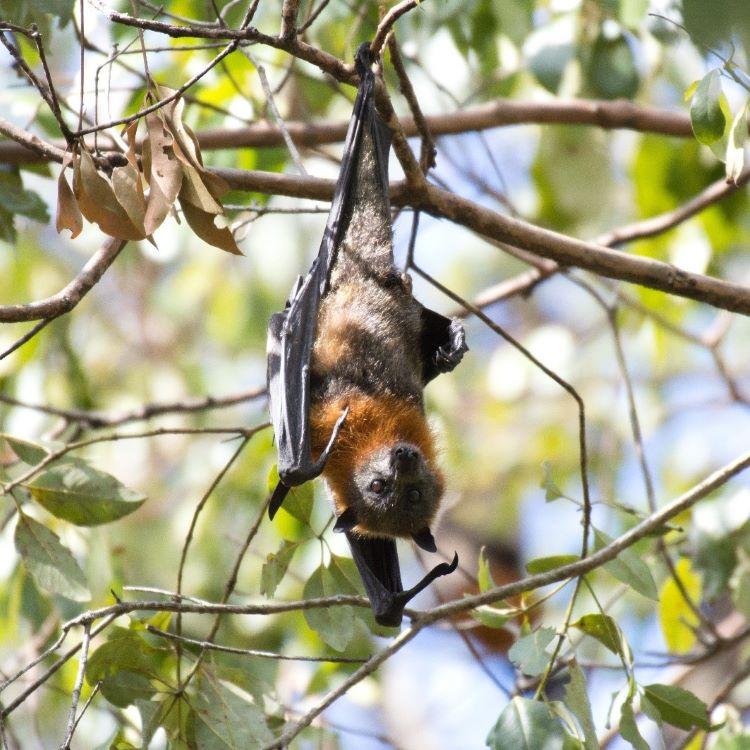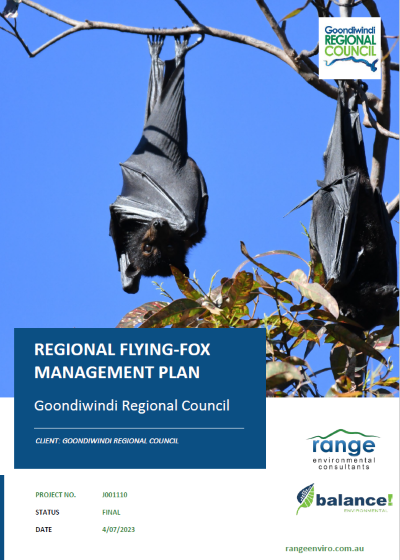Flying Foxes

Flying-foxes (also known as fruit bats) are a genus of megabats which occur across tropical and subtropical regions of Africa, Asia, Australia, and some oceanic islands. Locally, black and grey-headed flying-foxes are typically present all year round, with nomadic little red flying-foxes usually appearing in the warmer months following the flowering events of eucalyptus trees.

Grey-headed flying-fox
FLYING FOX ROOSTING MANAGEMENT POLICY
In recognition of the evolving impact and behaviours of wildlife and the community, this plan will be reviewed regularly with regard to feedback received from the community.
- Flying-foxes are intelligent, social animals that live in communal roost sites (roosts) during the day. Roosts may be occupied permanently, seasonally or sporadically, and may consist of dozens, or up to tens of thousands of individuals.
- Flying-foxes are capable of long-distance movements and regularly move between roosts. On any given day the individual animals within a roost can be different to the days and weeks before.
- Flying-foxes only give birth to one young per year. Dependent young cling to the mother’s underarm nipple with their mouth and hang onto the waist with their toes. Mothers carry their young when foraging for the first 3-4 weeks, and then leave them in a creche overnight and retrieve them at dawn.
- There are three species of flying-fox in the Goondiwindi Region:
- Black flying-fox (Pteropus alecto)
- Grey headed flying-fox (Pteropus poliocephalus)
- Little Red flying-fox (Pteropus scapulatus)
Flying-foxes play a role in regulating and maintaining the eastern Australian environment and are a keystone species within the eastern Australian states. Flying-foxes are key species in pollination of eucalypt and other forests and the dispersal of seeds from fruiting trees. Some trees like eucalypts only flower at night and depend on flying-foxes to pollinate their flowers and spread their seeds, as they are not serviced by day-feeding birds and bees.
Two permanent flying-fox camps are currently known to occur across the region including the Inglewood Apex Park roost and the Goondiwindi (Macyintyre River – Sandalwood Drive) roost. Further information on the location of current and historic flying-fox roosts is provided in Council’s regional flying-fox management plan.
During warmer months large numbers of little red flying-foxes are known to occupy these roosts, increasing noise and odour impacts to the community. These impacts typically subside with the natural migration of the little red flying foxes.
Council monitors flying fox numbers at known roosts in the region throughout the year to maintain an understanding of flying-fox roost impacts to the community.
Council adopts a balanced approach to flying-fox roost management that recognises the well-being of residents and the need for responsible management of wildlife in accordance with relevant legislation. Council provides regional leadership for management of flying-fox roosts on Council managed lands and has developed a regional flying-fox management plan which articulates Councils management position on flying-fox roosts.
The Queensland Government regulates the management of flying-fox roosts under the Nature Conservation Act 1992 with all land managers bound to the Code of Practice - Ecologically sustainable management of flying-fox roosts.
A very small percentage of flying-foxes carry Australian Bat Lyssavirus (ABLV). A bat bite, scratch or mucous membrane exposure to bat saliva (through eyes, nose or mouth) is necessary to transmit the virus. Coming into contact with flying fox urine or faeces does not pose a risk of exposure to ABLV, nor does living, playing or walking near roosts.
If you are bitten or scratched by a bat, immediately seek medical assistance and advise that you have been bitten or scratched by a flying-fox
For further information, visit Queensland Health for advice on ABLV.
Hendra virus was discovered following an outbreak of illness in horses in a large racing stable in the suburb of Hendra, Brisbane in 1994. The natural host for Hendra virus is the flying fox. The virus can spread from flying foxes to horses, horses to horses and rarely, from horses to people.
A vaccine to prevent Hendra virus infection in horses has been available since November 2012.
If you have had recent exposure to an infected horse and have not been contacted by public health staff, please telephone your nearest public health unit or 13 HEALTH (13 43 25 84).
For further information, visit Queensland Health for advice on Hendra virus.
Flying-foxes may roost within local bushland, isolated groups of trees or forage in your yard when seasonal food sources are available. Some simple steps residents can take to help minimise the impacts of living near flying-fox roosts include:
- Don’t leave your washing out at night – bring it in before dusk.
- Garage or cover your vehicles. Consider parking them away from fruiting trees.
- Use a pool cover.
- Cover or bring any outdoor furniture under shelter at night.
- Try not to disturb them – this will only make them noisier and heighten the odour.
If you have a roost on or near your land – you can still manage your property. The Queensland Government’s Code of Practice - Low impact activities affecting flying-fox roosts provides guidance on steps you can take to minimise impacts of flying-foxes while conducting activities such as mulching, mowing, weeding, watering under or near roost trees, minor trimming of roost trees, and installation, maintenance or removal of infrastructure.
Never attempt to rescue or handle injured flying-foxes.
If you find a sick or injured flying-fox, call a trained vaccinated handler to attend the bat: RSPCA (1300 ANIMAL), Department of Environment and Science (1300 130 372), or local wildlife care groups. Only trained and vaccinated handlers should touch bats.
Local Governments are authorised to carry out certain activities within flying fox roosts in urban areas in accordance with the Code of Practice - Ecologically sustainable management of flying fox roosts. Where private landholders seek to conduct management of flying-fox roosts they are required to apply for authorisation from the Department of Environment and Science to carry out the management actions. No authorisation is required for landholders to implement the Code of Practice - Low impact activities affecting flying-fox roosts on land under their control, allowing landholders to continue to reasonably manage their land through low impact activities.
Queensland's native wildlife, including flying foxes, are protected by the Nature Conservation Act 1992. Under the Act, no person must destroy, disturb or attempt to drive away a flying fox without a Damage Mitigation Permit. The Nature Conservation Act 1992 allows for authorised State Officers to issue enforcement and penalty infringement notices for unauthorised activities.
Where residents seek to undertake management of flying-fox roosts on their land they are encouraged to contact Council and the Department of Environment and Science for advice.


